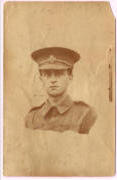
Abstracted from Newsletter 60
As part of the wider Cirencester Commemorates 1914-18 initiative sponsored by the Heritage Lottery Fund, the Society researched and presented an exhibition in the Corinium Museum with the same title. This was launched to favourable comments at a very enjoyable gathering on 14 August 2014 and ran until 14 September. The work put into that forms only part of the wider and longer-term Society project researching the stories behind the names of all those who appear on Cirencester’s several war memorials, leading it is hoped towards a suitable permanent publication of some kind. The short summary included here of one such individual shows what can be gathered together by a study group approach to research of this kind. Many thanks to Robert Webb, who was born in Cirencester in 1926 but moved away in 1938 and is now living in retirement in Devon, for providing this information so readily. We are able to include here only a part, but enough as an exemplar of what can be achieved.
Cirencester Commemorates 1914-18:
Frank Webb of Cirencester,
killed at Ypres on 04 June 1915
My Webb family entered Cirencester in 1901 when Superintendent of Police Frank Webb was appointed to the Cirencester and Tetbury Division of the Gloucestershire Police. He brought his family and until 1908 they lived at the old Police Station at the end of Castle Street and Supt Webb died there in 1908.
Following this his widow Charlotte Webb together with two sons and four daughters moved to a house in Lewis Lane which at that time was numbered No1 Chester Terrace. This row runs between Chester Villa and the turn to Tower Street and No.1 was the end house to the west.
The elder of the sons (and the subject of this note) was Frank Langston Webb, born in 1894 and who after attending the old Council School in Lewis Lane was apprenticed to Samuel Clappen, men’s outfitters in Cricklade Street. As a boy in Cirencester Frank was a keen sportsman, and he was in the local scouts and was a member of the Church Lads Brigade.
By August 1914 he had moved on and was working in London. He was swept up in the rush to enlist and his name appears in a book in which the author says that “he and a friend F.L. Webb talked it over on Wednesday August 5th 1914 and decided that they must do something and decided to enlist.” They decided to “say nothing to nobody but to volunteer.”
After attempting to join another regiment and getting lost in St John’s Wood, they found the Headquarters of the Queens Westminster Rifles, a London based Territorial unit where they joined a queue and after waiting for two hours were given a number to return the next day. They were then were sworn in and became soldiers. After some training in London where it seems the free travel on buses was the high point, they joined the battalion at Leverstock Green in Hertfordshire.
From then on, Frank kept a diary and wrote regularly to his mother in Cirencester. These documents were kept and are still with the family. They tell us that after 8 weeks of training the Queens Westminster Rifles were one of several Territorial Army units used to reinforce the British army in France.
Frank sailed from Southampton on November 1st 1914 and was in the front line at Armentieres by the 16th. Over the next few months the battalion alternated between the front line and reserve duties. On Christmas Day 1914 Frank was in the front line and his letters tell of the “Christmas Truce” and how he and others met German soldiers between the trenches, shook hands and wished each other a good Christmas. In particular, he and a German soldier exchanged buttons and this together with the Christmas box sent to all British soldiers is still in the family.
In early 1915 the battalion was transferred to Ypres where on 4th June it was heavily shelled whilst moving up to the front line from reserve trenches. Seven soldiers were killed, one of whom was Frank Webb.
Letters to his mother from the unit told her that he had been buried at the Potije Burial Ground but after the war the War Graves Commission was unable to locate the burial place and his name now appears on the Menin Gate Memorial as one of the many who have no known grave. At his death Frank was aged 21 yrs and 3 months. The letter written by his company commander survives and is especially poignant.
A photograph of Frank appeared in the Wilts and Gloucestershire Standard of June 10th 1915 which announced his death (along with many others). His name is on both of the town’s main war memorials – outside the church and on the former chapel in Sheep Street, and also on the Church Lads Brigade plaque inside the church. Robert WebbSee also the Memorial Page Webb F L
